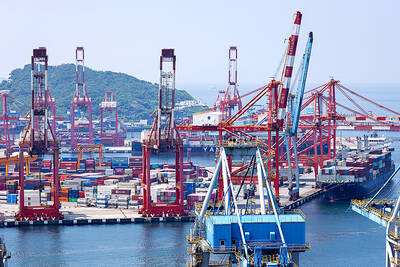Hospitals saw revenues drop by over 50 percent last month after SARS clusters in several facilities kept all but the bravest people away from doctor appointments.
"In addition to over 50 percent revenue losses in May, National Taiwan University Hospital has spent over NT$100 million treating more than 200 SARS patients," hospital Vice Superintendent Hsu Su-ming (
Clinic visits at the facility plummeted after the outbreak of SARS in late April.
National Taiwan University Hospital -- the nation's leading hospital in treating SARS victims -- on average, saw only 2,000 to 3,000 patients a day last month -- down from 7,000 patients per day before the virus outbreak, Hsu said.
Its revenue losses are estimated to be in the hundred of millions of NT dollars after it took in the nation's first SARS patient in mid-March.
Hsu, however, said that after the nation began to contain SARS this month, the hospital began to see more people coming for treatment and now has about 4,000 appointments per day.
Although the government has promised to compensate hospitals for their losses stemming from treating SARS patients, National Taiwan University Hospital has been too busy to file a claim and so hasn't received any subsidies yet, Hsu said.
According to a local media report, large hospitals such as National Taiwan University Hospital, Veterans General Hospital and Mackay Memorial Hospital were hardest-hit by SARS, suffering revenue drops of at least 30 percent last month.
The report speculated that big hospitals might have incurred NT$6 billion in total losses last month, although it failed to provide details on the number of hospitals.
Officials at the Department of Health and the Bureau of National Health Insurance yesterday refused to confirm the report's accuracy, saying that figures will only be available after the SARS-affected hospitals complete their health insurance claims later this month.
Municipal hospitals, such as Taipei Municipal Jen Ai Hospital and Jen Chi Hospital, were also badly hit by the virus and suffered a 10 to 20 percent decline in business last month, according to the report.
After taking in 34 SARS patients, Chang Gung Memorial Hospital in Keelung saw a 30 percent decline in business last month, losing over NT$40 million in one month according to administrative supervisor Tai Hsin-yeh (
Early this month, however, the hospital's business began to recover, seeing only a 15 percent decline, Tai said.
To weather the SARS impact, he said that the hospital has encouraged its medical staff to take vacations or combine their practices.
The epidemic has also affected small clinics which have not been treating SARS cases.
The University Eye Center, which specializes in corrective laser eye surgery, saw business decline by 20 to 30 percent according to its marketing manager, Chen Jung-jay (陳榮杰).
Chen said that the center had treated many patients who suffered from eye disorders and required immediate care, but those seeking corrective surgery have been taking a wait-and-see approach before scheduling appointments.

Nvidia Corp chief executive officer Jensen Huang (黃仁勳) on Monday introduced the company’s latest supercomputer platform, featuring six new chips made by Taiwan Semiconductor Manufacturing Co (TSMC, 台積電), saying that it is now “in full production.” “If Vera Rubin is going to be in time for this year, it must be in production by now, and so, today I can tell you that Vera Rubin is in full production,” Huang said during his keynote speech at CES in Las Vegas. The rollout of six concurrent chips for Vera Rubin — the company’s next-generation artificial intelligence (AI) computing platform — marks a strategic

REVENUE PERFORMANCE: Cloud and network products, and electronic components saw strong increases, while smart consumer electronics and computing products fell Hon Hai Precision Industry Co (鴻海精密) yesterday posted 26.51 percent quarterly growth in revenue for last quarter to NT$2.6 trillion (US$82.44 billion), the strongest on record for the period and above expectations, but the company forecast a slight revenue dip this quarter due to seasonal factors. On an annual basis, revenue last quarter grew 22.07 percent, the company said. Analysts on average estimated about NT$2.4 trillion increase. Hon Hai, which assembles servers for Nvidia Corp and iPhones for Apple Inc, is expanding its capacity in the US, adding artificial intelligence (AI) server production in Wisconsin and Texas, where it operates established campuses. This

Garment maker Makalot Industrial Co (聚陽) yesterday reported lower-than-expected fourth-quarter revenue of NT$7.93 billion (US$251.44 million), down 9.48 percent from NT$8.76 billion a year earlier. On a quarterly basis, revenue fell 10.83 percent from NT$8.89 billion, company data showed. The figure was also lower than market expectations of NT$8.05 billion, according to data compiled by Yuanta Securities Investment and Consulting Co (元大投顧), which had projected NT$8.22 billion. Makalot’s revenue this quarter would likely increase by a mid-teens percentage as the industry is entering its high season, Yuanta said. Overall, Makalot’s revenue last year totaled NT$34.43 billion, down 3.08 percent from its record NT$35.52

PRECEDENTED TIMES: In news that surely does not shock, AI and tech exports drove a banner for exports last year as Taiwan’s economic growth experienced a flood tide Taiwan’s exports delivered a blockbuster finish to last year with last month’s shipments rising at the second-highest pace on record as demand for artificial intelligence (AI) hardware and advanced computing remained strong, the Ministry of Finance said yesterday. Exports surged 43.4 percent from a year earlier to US$62.48 billion last month, extending growth to 26 consecutive months. Imports climbed 14.9 percent to US$43.04 billion, the second-highest monthly level historically, resulting in a trade surplus of US$19.43 billion — more than double that of the year before. Department of Statistics Director-General Beatrice Tsai (蔡美娜) described the performance as “surprisingly outstanding,” forecasting export growth